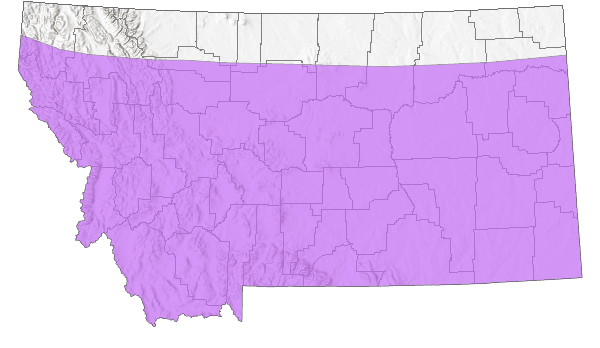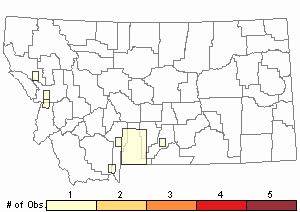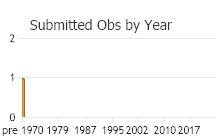View in other NatureServe Network Field Guides
NatureServe
Montana
Utah
Wyoming
Idaho
Wisconsin
British Columbia
South Carolina
Yukon
California
New York
Ornate Pygmy Grasshopper - Tetrix ornata
Other Names:
Ornate Grouse Locust
General Description
The following comes from Brooks (1958), Helfer (1971), Vickery and Kevan (1985), Bland (2003), and Scott (2010). Larger eyes, both in dorsal and lateral views, than other Tetrix species. Body color blackish to brownish, sometimes variously marked. Pronotum can be short or long.
Phenology
Overwinters as adults, which are active from late March and April (in most northern latitudes) into September, with peak populations occurring in spring and fall. Nymphs are most common from late spring to midsummer (Scott 2010, and Vickery and Kevan 1985).
Diagnostic Characteristics
The following is taken from Brooks (1958), Helfer (1971), Vickery and Kevan (1985), Bland (2003), and Scott (2010). Pronotum length for males is 8 mm, and for females 9 mm to 10 mm, roof-like and pointed. Hind femur is robust and inflated, less so in males. Middle leg femur is narrow not inflated.
Easily confused with the other two Montana
Tetrix species,
Slender Grouse Locust (
T. subulata) and
Brunner's Grouse Locust (
Tetrix brunnerii).
Species Range
Montana Range
Range Descriptions

 Native
Native
Range Comments
Occurs from the Yukon across Canada to New Brunswick. Across the United States from the western border of Montana eastward to the New England states and southward into New Mexico to North Carolina. In Montana, it has been reported for 7 counties (Bland 2003, Brooks 1958, Helfer 1971, Scott 2010, and Vickery and Kevan 1985).
Observations in Montana Natural Heritage Program Database
Number of Observations: 8
(Click on the following maps and charts to see full sized version)
Map Help and Descriptions
Relative Density

Recency


 (Observations spanning multiple months or years are excluded from time charts)
(Observations spanning multiple months or years are excluded from time charts)
Habitat
Found in a variety of habitats but prefers bare or damp grassy areas around unshaded edges of ponds. Generally, occurs in drier habitats than
Slender Grouse Locust (
T. subulata). One study found
T. ornata occurring with
T. subulata in damp depressions in a generally dry Ponderosa pine forest at 4,200 feet (Bland 2003, Brooks 1958, Helfer 1971, and Vickery and Kevan 1985).
Food Habits
No specific food habit studies found in the literature search for this species, but probably similar to that of
Slender Grouse Locust (
T. subulata). Refer to that species.
Reproductive Characteristics
No specific reproductive studies found in the literature search for this species, but probably similar to that of
Slender Grouse Locust (
T. subulata). Refer to that species.
Stewardship Responsibility
References
- Literature Cited AboveLegend:
 View Online Publication
View Online Publication Bland, R.G. 2003. The Orthoptera of Michigan—Biology, Keys, and Descriptions of Grasshoppers, Katydids, and Crickets. East Lansing, MI: Michigan State University Extension, Bulletin E-2815. 221 p.
Bland, R.G. 2003. The Orthoptera of Michigan—Biology, Keys, and Descriptions of Grasshoppers, Katydids, and Crickets. East Lansing, MI: Michigan State University Extension, Bulletin E-2815. 221 p. Brooks, A.R. 1958. Acridoidea of Southern Alberta, Saskatchewan, and Manitoba (Orthoptera). The Canadian Entomologist (Supplement 9) 90:5-92.
Brooks, A.R. 1958. Acridoidea of Southern Alberta, Saskatchewan, and Manitoba (Orthoptera). The Canadian Entomologist (Supplement 9) 90:5-92. Helfer, J.R. 1971. How to Know the Grasshoppers, Crickets, Cockroaches, and Their Allies. Revised edition (out of print), Mineola, NY: Dover Publications.
Helfer, J.R. 1971. How to Know the Grasshoppers, Crickets, Cockroaches, and Their Allies. Revised edition (out of print), Mineola, NY: Dover Publications. Scott, R.D. 2010. Montana Grasshoppers, Katydids, and Crickets A Pictorial Field Guide to the Orthoptera. MagpieMTGraphics, Billings, MT.
Scott, R.D. 2010. Montana Grasshoppers, Katydids, and Crickets A Pictorial Field Guide to the Orthoptera. MagpieMTGraphics, Billings, MT. Vickery, V. R. and D. K. M. Kevan. 1985. The grasshopper, crickets, and related insects of Canada and adjacent regions. Biosystematics Research Institute, Ottawa, Ontario. Publication Number 1777. 918 pp.
Vickery, V. R. and D. K. M. Kevan. 1985. The grasshopper, crickets, and related insects of Canada and adjacent regions. Biosystematics Research Institute, Ottawa, Ontario. Publication Number 1777. 918 pp.
- Additional ReferencesLegend:
 View Online Publication
View Online Publication
Do you know of a citation we're missing? Capinera, J.L., R.D. Scott, and T.J. Walker. 2004. Field Guide to Grasshoppers, Katydids, and Crickets of the United States. Ithaca, NY. Cornell University Press.
Capinera, J.L., R.D. Scott, and T.J. Walker. 2004. Field Guide to Grasshoppers, Katydids, and Crickets of the United States. Ithaca, NY. Cornell University Press. Hebard, M. 1928. The Orthoptera of Montana. Proceedings of the Academy of Natural Sciences of Philadelphia, Vol. 80:211-306.
Hebard, M. 1928. The Orthoptera of Montana. Proceedings of the Academy of Natural Sciences of Philadelphia, Vol. 80:211-306.
- Web Search Engines for Articles on "Ornate Pygmy Grasshopper"
- Additional Sources of Information Related to "Insects"





